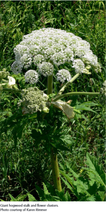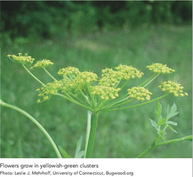 Giant Hogweed The stems and leaves of this plant are covered with small hairs coated with poisonous sap. Even the slightest touch can cause painful blisters and severe skin irritation. The symptoms can take a couple of days to develop with the skin becoming highly photosensitive producing large watery blisters; however the effects can be long lasting, with contact resulting in recurrent dermatitis. This is a particular concern for small children who may use the stems as pea-shooters or pretend telescopes resulting in horrific injuries. What does Hogweed Look Like?
 Wild Parsnip Is another weed that should also be avoided. The effects are similar to those associated with Giant Hog Weed. Irritation can occur if your skin contacts the plant’s fluids and is then exposed to sunlight. Contact with the eyes can cause temporary blindness and in rare cases permanent blindness. Wild parsnip can be found within uncultivated land, roadside ditches, parklands, nature trails and sports fields as well as on and around residential properties. What Does Wild Parsnip Look Like?
Being able to readily identify wild parsnip and giant hogweed will minimize accidental exposure to these plants and the painful results that follow. Anyone having information on specific locations where these weeds are posing a public risk should contact the Invading Species Hotline at 1-800-563-7711. You will be asked to send in photos for identification. DO NOT touch, cut or collect parts of the plant. The Temagami Medical Centre and Family Health Team ... committed to keeping you as healthy as possible! Comments are closed.
|
AuthorEllen Ibey Archives
August 2022
Categories
All
|
Temagami Medical Centre and Family Health Team provides quality inter-disciplinary health care to Temagami and area.
Patient SurveyIf you're a Temagami FHT patient, we want to hear your input! Click below to fill out our Patient Experience Survey. |
What's New?There's always something going on at the Temagami FHT. Check out our calendar for up-to-date events, and click below for our news page, updated weekly with the latest tips and information!
|
Further information |
About |
Programs |
|

 RSS Feed
RSS Feed
